How Big is the Political Divide Between Mainline Clergy and Laity?
I finally get to answer a frequently asked question
My new book releases on on January 13, 2026. It’s called The Vanishing Church: How the Hollowing Out of Moderate Congregations Is Hurting Democracy, Faith, and Us. Please pre-order a copy on Amazon or Baker Books (where it’s currently 40% off with free shipping).
I had to read the book Moby-Dick in high school. I was not a fan. I’m still not a fan. But there’s one idea from that book that has stuck with me for the last twenty-five years: the white whale. In Melville’s book, Captain Ahab has a boat that is destroyed by a giant sperm whale. It changes the course of his life because he spends the rest of his days trying to track it down and kill it. In modern parlance, it’s a problem that seems unsolvable.
I’m not going to list all of my white whales outright because some of you might actually steal the idea from me! But I am going to be able to answer one of my eternal questions today in a way I’ve never been able to before:
How big is the political divide between the clergy and the laity in mainline Protestant Christianity?
It’s a question that gets posed to me all the time, especially when I do any kind of writing about the political leanings of the average mainline Protestants who sit in the pews of local United Methodist or Episcopal churches. That became especially acute when I was working through my post-mortem on the 2024 election and I wrote a post about the mainline.
2024 Election Post-Mortem: Mainline Protestants
I give a few talks here and there to a whole bunch of different audiences. Some of them are really knowledgeable about the world of religion. Think seminaries and religious studies departments. Others are given to groups of undergraduates or community groups.
Here’s the upshot of that post: a majority of mainline Protestant Christians voted for Donald Trump in 2024. They also supported him in 2020 and 2016. In fact, even during Barack Obama’s landslide election in 2008, the mainline was evenly divided at the ballot box. There’s a common perception out there that mainline Protestants are a bunch of card-carrying leftists who love to post rainbow flags outside their churches. And while their theology may be to the left of Southern Baptists, their politics are decidedly conservative.
Literally the first comment on that prior post was, “Do you have comparable data that isolates the clergy in the mainline?” Well, today, friends, I can say that I do. The data comes from the Public Religion Research Institute’s Data Vault. They surveyed over 3,000 pastors from the Seven Sisters of the Mainline throughout 2022 and 2023.
So, let’s start with a question about political partisanship. I compared the laity in each tradition to the corresponding denomination in the Cooperative Election Study (which is a survey of the laity).
And upshot of this graph is pretty easy to discern: the political partisanship of the average mainline pastor diverges significantly from the politics of the folks sitting in their pews. I don’t think the differences are huge when comparing the Democratic share of each group, though. For instance, among United Methodists, about 38% identify as Democrats—whether clergy or laity.
For the ELCA, clergy are 13 points more likely to be Democrats. Among PCUSA leaders, 61% are Democrats compared to only 39% of the membership. The biggest gap shows up in the United Church of Christ. Among clergy, 71% are Democrats, while just 46% of the laity identify that way.
But I think the most telling statistic is the share of each group that aligns with the Republican Party. It was so striking that I decided to make a separate graph about it (because I know it’s probably going to get a lot of traffic on social media). I also wanted to add a margin of error calculation so we can clearly see that these differences are statistically significant.
There’s no other way to describe these graphs than an absolute chasm between the clergy and laity in basically every single one of the Seven Sisters. I do need to make a quick note about the American Baptists, though. There were only 62 of them in the clergy sample, so I would take those results with a huge grain of salt in all of the analysis going forward. But in many other traditions, there are hundreds of religious leaders in the PRRI sample, which gives us a lot more certainty about the accuracy of the estimates.
Less than ten percent of pastors in the ELCA and PCUSA identify as Republican, but nearly half of the folks sitting in their pews align with the GOP. It’s almost impossible to find a United Church of Christ pastor who is a Republican (just 3%), but more than 40% of their laity identify that way. Among Episcopalians, 35% of members are Republicans compared to just 7% of their pastors.
I don’t know how else to say this: the pulpit looks nothing like the pews in mainline houses of worship. And the perception of mainline politics is driven by the leadership—or at least that’s the impression I get when I talk about the mainline with a general audience.
I also wanted to do a quick crosstab on this based on gender. I was curious whether female mainline pastors were more left-leaning than their male counterparts, and how much that diverged from women who are members of their churches. First, let me show you the gender composition of each tradition to help us get our bearings.
In the entire sample, about three-quarters of the pastors were men, and women made up about 20% of the clergy. The numbers didn’t deviate too much from the overall mean. It does look like the United Methodist Church is slightly more male-dominated (80%), while the United Church of Christ and the PCUSA have the largest share of female pastors at 27% and 29%, respectively. But for this analysis, I’m going to group all the mainline clergy together so the sample size doesn’t get too small.
Here’s what I find absolutely fascinating when comparing men in both samples: the share who say they are Democrats doesn’t really differ that much (44% among clergy and 38% among the laity). The big difference is the share who are Republicans—50% of the laity versus 17% of the clergy. A whole bunch of male mainline pastors say they are independents. I don’t really know what to make of that.
The results when comparing women are much more striking. Among female clergy in the mainline, over 70% say they are Democrats, while just 5% identify as Republicans. Just ruminate on that for a second—about a third of all women in the United States identify as Republicans, by comparison. Among women who sit in the pews of a mainline church, the split is much more even (47% Democrats and 44% Republicans). So the gap is even more striking when viewed through the lens of gender.
What about political ideology? The survey asked if folks identified as conservative, moderate, liberal, or something else. Here, I’m just looking at the share of each group who said they were liberal, comparing the clergy sample and the mainline membership.
Again, these gaps are absolutely huge in most traditions. There are two groups that buck the trend. One is the American Baptists, but given their small sample size, I think we need to interpret that result cautiously. The other is the United Methodists. Among those in the pews, 21% say they are liberal, while 38% of those in the pulpit use the same label. But even that’s a relatively small gap compared to the other denominations.
Among the ELCA and PCUSA, 60% of pastors say they are liberal, compared to just a quarter of their membership. Among Episcopalians, 60% of pastors are liberal versus 34% of the laity. The biggest gap of all belongs to the United Church of Christ: 71% of pastors identify as liberal compared to 27% of their members—a 44-point gap.
For a reference point, 28% of all Americans identify as liberal. That’s almost exactly the same share you’ll find in the pews of the average mainline church. The pulpit, however, is another thing entirely.
Since I’ve now shown you both the partisanship and ideology measures of each sample, I thought it would be helpful to combine them into a single analysis. This next heatmap shows the distribution of both variables across clergy and laity in mainline traditions.
The most likely landing spot for mainline clergy? Liberal Democrats—that describes nearly half of them (45%). In total, about 56% of all mainline clergy say they are liberal, and 53% say they are Democrats. The share who are conservative Republicans? Just 12%. In fact, only 21% of them describe themselves as ideologically conservative at all—nearly the same share say they are moderates, too (22%).
The most likely square for the membership of mainline churches? Conservative Republicans—37%. A person sitting in the pews is about three times more likely to land in the top-right corner of the heatmap compared to their leadership. At the same time, the bottom-left corner (liberal Democrats) makes up just 24% of the laity. That’s half the rate of the clergy in their tradition.
Again—it’s hard to overstate just how different the worldview is between the people leading these churches and those who are members of these traditions.
When I was poking around in this data, I thought I’d see whether other variables led to big differences in the results. The first thing I looked at was the size of the congregations of mainline clergy. I had a theory that smaller churches tended to be more rural, and rural areas tend to be more conservative, so it would logically follow that these pastors would lean more to the right. Guess what? I didn’t see that at all. In fact, there was no difference whatsoever.
But age proved to be an interesting demographic factor.
Among mainline clergy between the ages of 18 and 40, the tilt to the left is incredible. Nearly 60% say they are liberal Democrats. Just 10% say they are conservative, and only 5% identify as Republicans. There may be no lonelier demographic in America than a young mainline pastor who is politically right of center.
The pulpit-and-pew divide is even starker when looking just at younger mainline members. I’ve written about this before—young Methodists and Episcopalians are not some super-liberal voting bloc. I’d actually describe them as slightly right of center, and that comes through in this analysis as well. About a third say they are conservative Republicans—nearly the same share who say they are liberal Democrats. Think about this: just 5% of young mainline clergy are conservative Republicans, compared to 29% of their young members.
The gaps among older folks in both samples are also significant. A member of the clergy is twice as likely to be a liberal Democrat compared to the laity (44% vs. 22%). Meanwhile, 38% of members are conservative Republicans compared to only 13% of older mainline leaders.
Why It's Really Hard to Be Optimistic About the Mainline
I’ve gotta say - the comments I get on this Substack tend to be really high quality. Which is nice! Nothing is worse than scrolling through my mentions on Twitter and seeing a bunch of ignorant, ill-informed folks spew nonsense just to elicit a response from me (or someone else). Word to the wise - don’t take the bait. Just keep scrolling.
At this point, I feel like I’m repeating myself: mainline clergy are decidedly left of center politically. Meanwhile, their membership is politically diverse and, by many estimates, ends up slightly right of center on matters of partisanship and ideology.
This should prompt a whole lot of reflection among denominational leaders of the Seven Sisters—but I’m not sure it will. Why are your seminaries and pulpits primarily attracting liberals? Would a Republican even feel comfortable attending classes and working toward ordination?
I can’t imagine anyone would be able to make the case that this is a good thing. The mainline is already in a demographic crisis, and I can’t help but feel that its decline is only accelerated by the growing divide between what the leadership wants and what the faithful members in the pews desire.
Don’t get mad at me. Get mad at the data.
Code for this post can be found here.





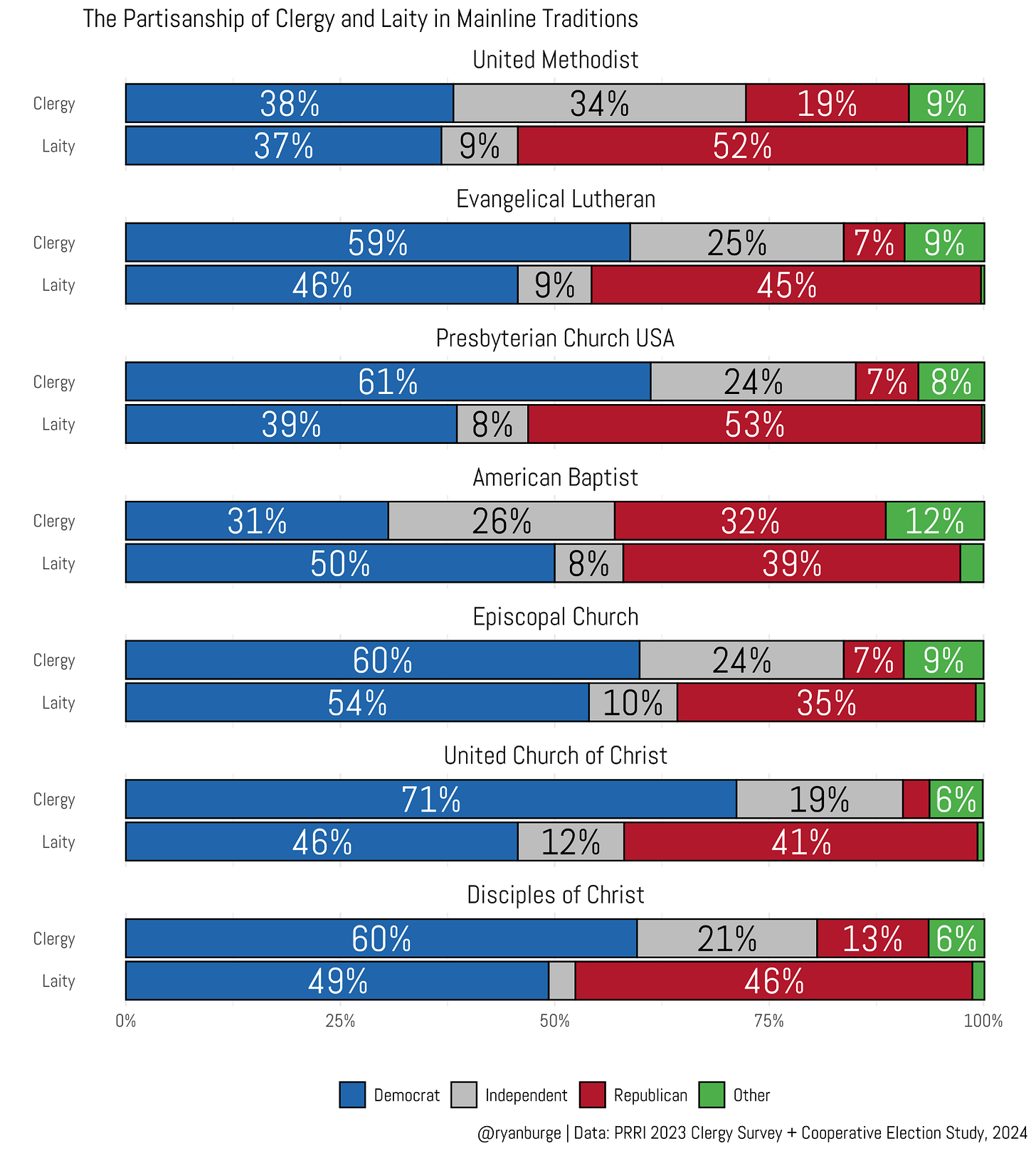

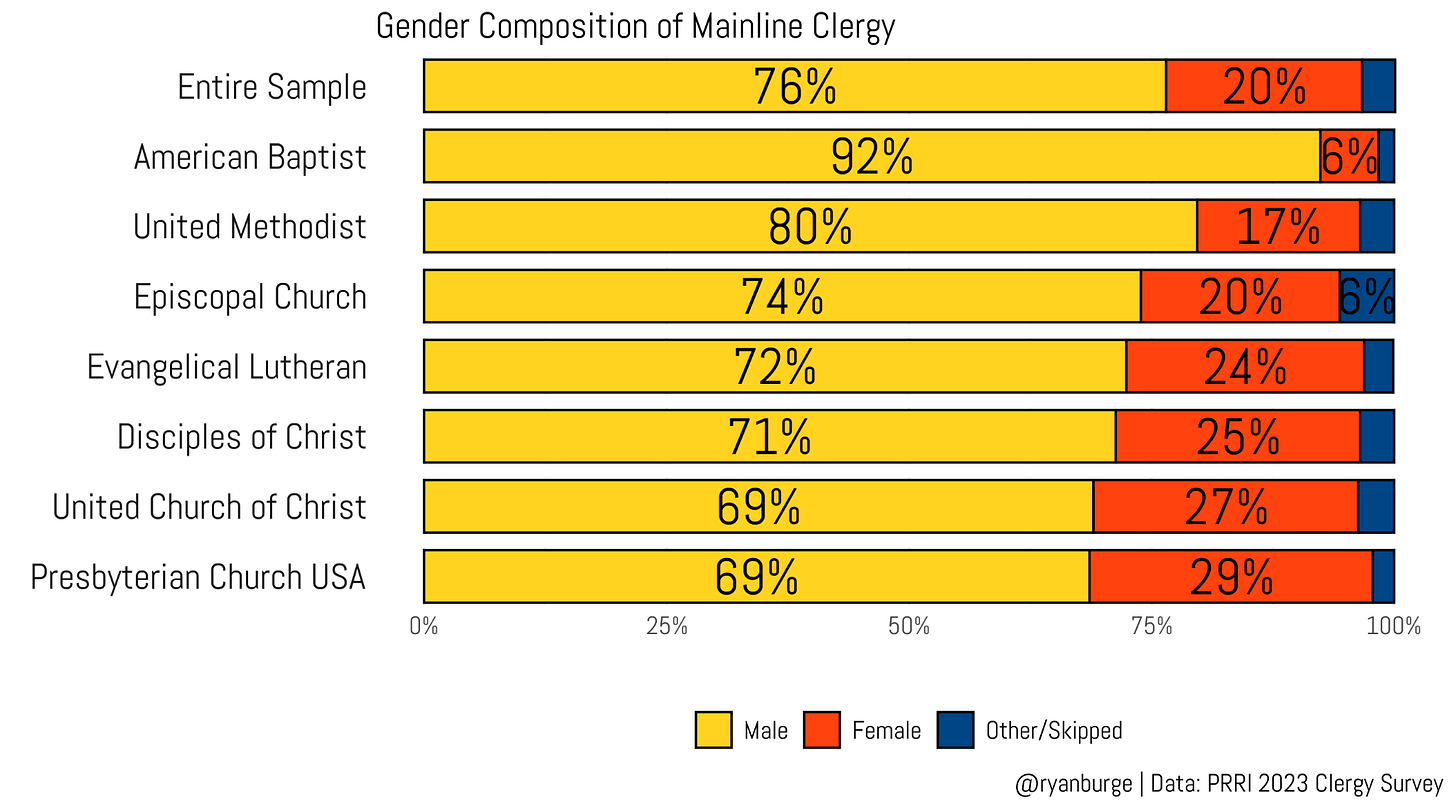
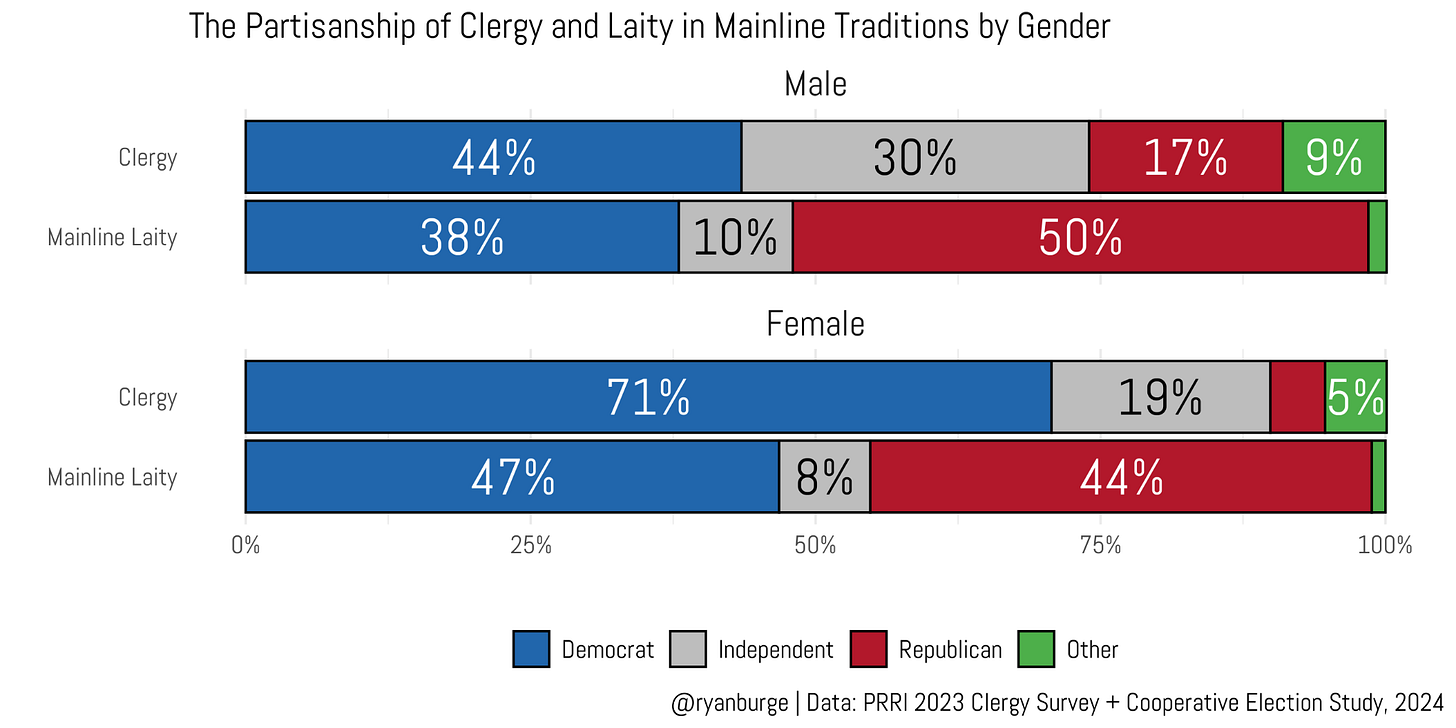

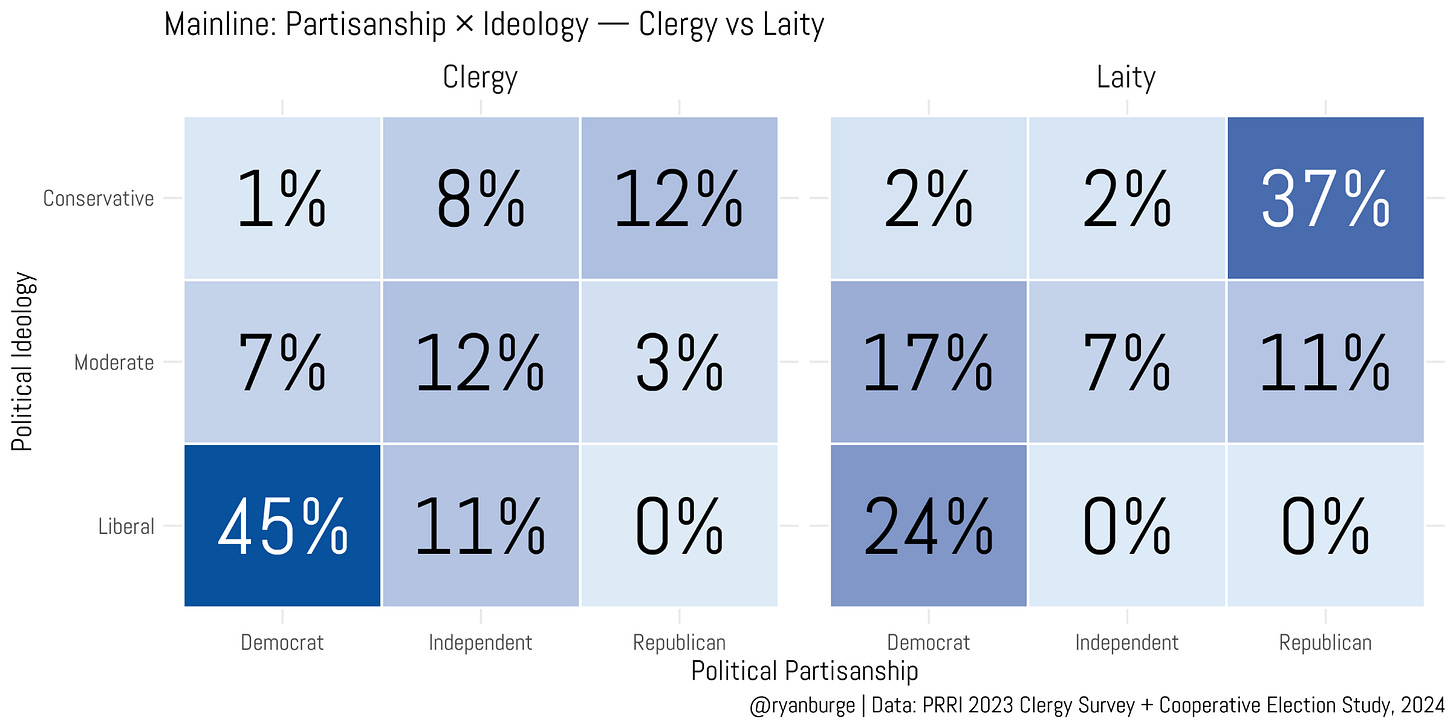
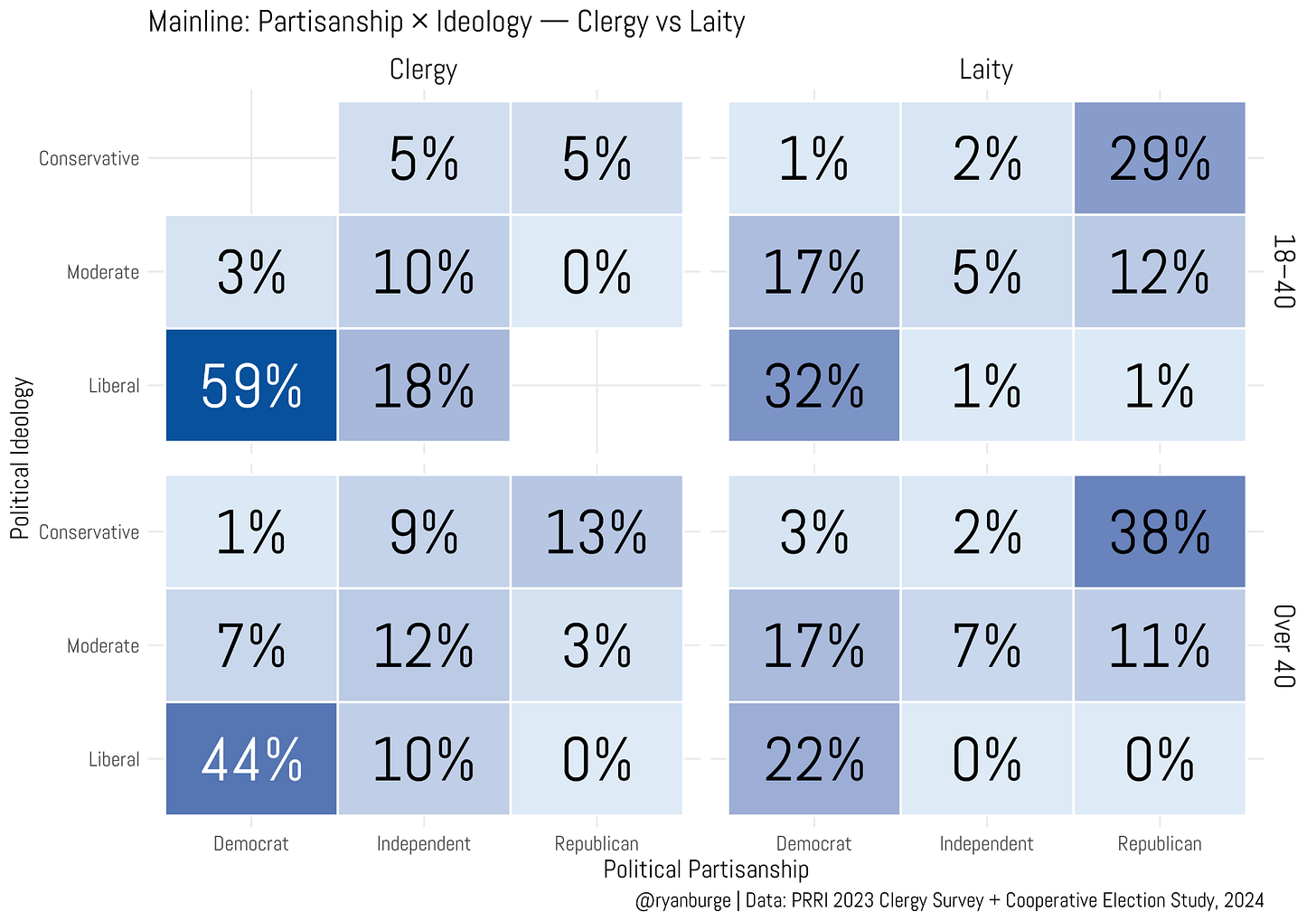
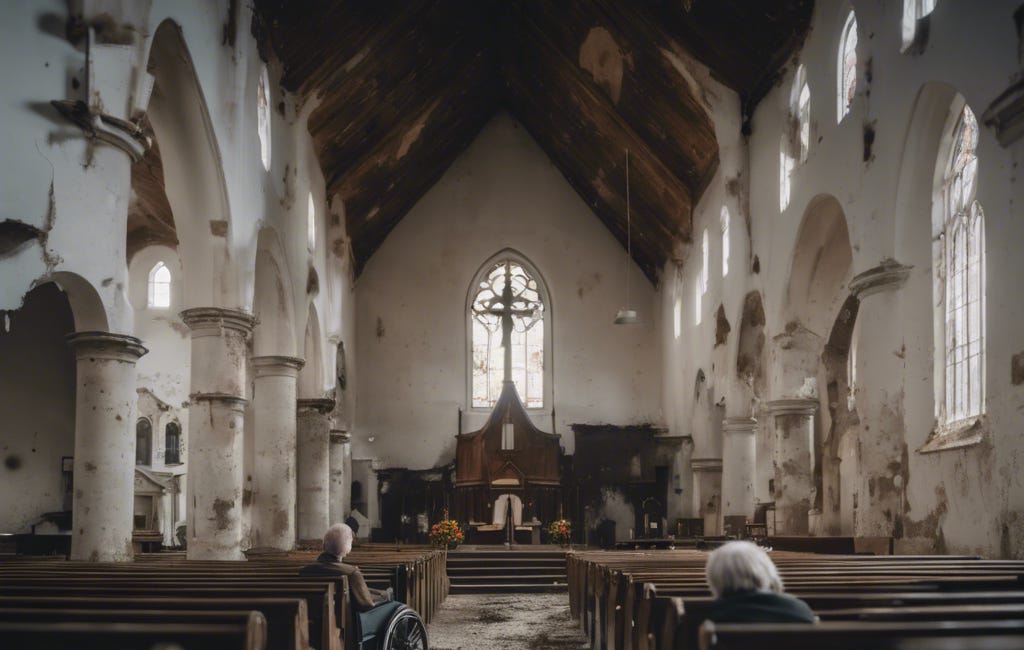
Not surprising at all. In every institution, religious or commercial or educational, leaders are strictly required to be orthodox Democrats. Workers and customers are evenly split, MOSTLY not interested in the whole pointless mess of political arguing.
One number does surprise me. Based on pastors and seminarians I knew a long time ago, I figured that nearly all Episcopal pastors would be female by now. But they're not significantly different from others.
Guess this is the question that we ask about other people and things. Do I want my doctor, teacher, rabbi, or elected representative to be just like me or to be better than me? Different churches have different ways of choosing their leaders. We hire our rabbis by search committees composed of congregants. The umbrella groups have rules of who we may hire, though my shul has an open search. I don't think we asked any of the candidates about their political affiliation. It is my understanding that some Protestant denominations elect their pastors in a similar way, while others have them assigned by the denominational infrastructure, as do the Catholics.
The divide between worshipers and clergy appears in Judaism, or is emerging, though not necessarily political. The rabbinical pipeline is changing. A study released this week showed that the incoming non-Orthodox group that congregations will need to hire, if these people want to go to synagogues at all when they have other options, will be over-represented by gays and women. https://atrarabbis.org/research/rabbinic-pipeline-study/ Those are the people who enroll in our seminaries, not the careerists of my generation who seemed much like the kids who went to law and medical school or latched onto their family businesses.
No reason to think that Christians attending college today will make their decisions to enroll in seminary much differently, producing a parallel group for the churches to hire.